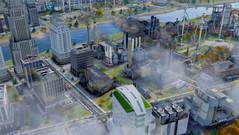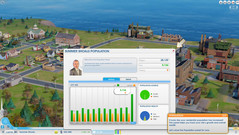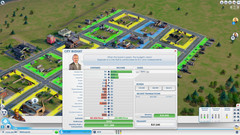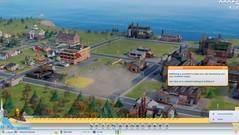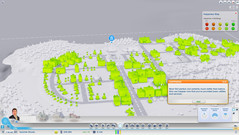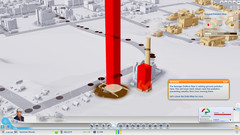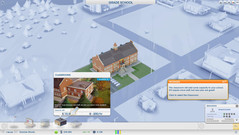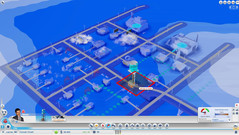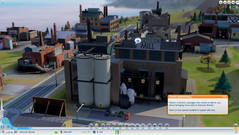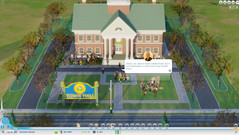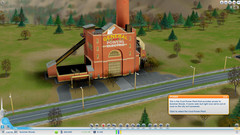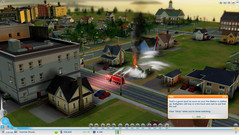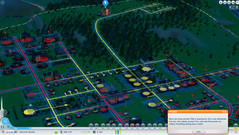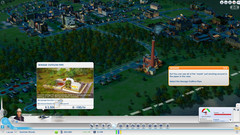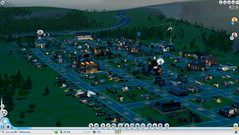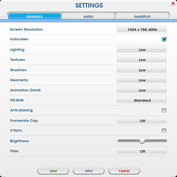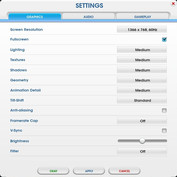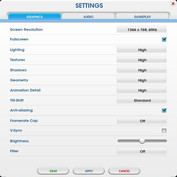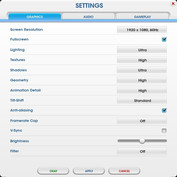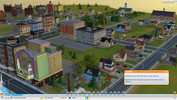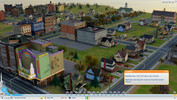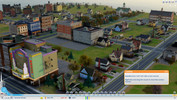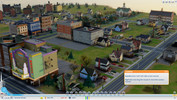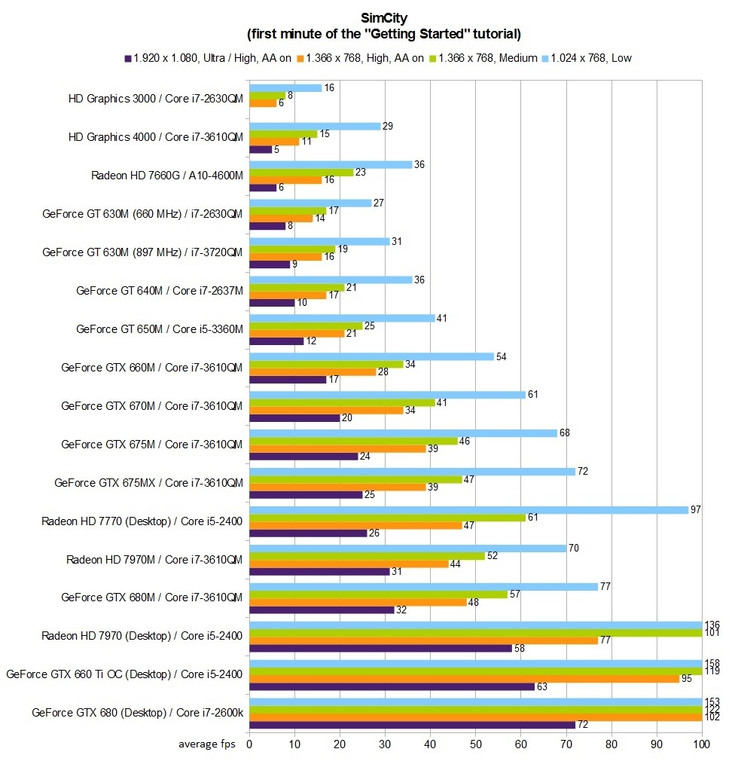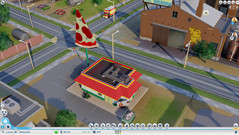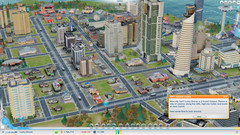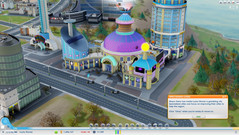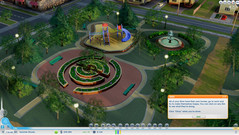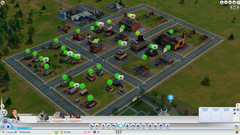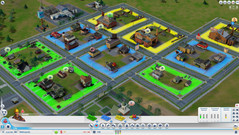SimCity Benchmarked
Description
For the original German review, see here.
Before we come to the content, we have to sharply rebuke the publishers for forcing gamers to use the internet to play the game. Every critic who despises permanent internet connections will have a field day with this title: Contrary to its promises, just days after its release the game wasn't functioning properly due to a server overload. Those on the fence as to whether to purchase the game or not will see this as a serious weakness. Luckily, after dozens of hours and login attempts, we managed to perform all our necessary benchmark tests.
Let's start with a few general impressions. After a charming and well-made intro video, the game offers us a short tutorial. There we learn SimCity's most important basics. We especially liked how the developers divided the basics into three simple area categories, which is particularly helpful for beginners. At lightning speed we lay down residential areas (green), commercial districts (blue) or industrial sites (yellow) on appropriate streets. The individual buildings are then built by the game automatically.
Here we notice the developers' incredible attention to detail. A house isn't suddenly set down on the land - it's actually built by construction workers. After the house is completed, a moving van comes with the new residents, who walk around the house turning lights on here and there. The fact that almost every building looks different also displays the effort and love the US studio put into their work.
On the subject of atmosphere, SimCity doesn't need to hear any criticism. The lovely animations, the great sound effects and the relaxing music make it easy to forget the real world. Depending on the zoom level we can both hear and see tons of details, like babbling citizens, cars driving around, shootings, protests and fire department operations. Speaking of the fire department: Most activities that take place in the city are so vividly presented that you don't really need to look at the intelligently designed (albeit occasionally a little fragmented) menus.
That's not to say that urban development takes place on its own and experts aren't handed both challenges and extensive opportunities. The innumerable statistics and special views found in various menus provide deep insight into the underlying mechanics of the city, when such information is desired. Here Maxis performs an impressive balancing act between accessibility and breadth. The bigger a city becomes, the higher the demands and needs of the citizens. While in the beginning they need little more than power, water and a working trash service, soon you'll need to set up a school, police station, and hospital.
Thanks to the easy controls and direct feedback (multi-colored bubbles in the game world) everything can be comfortably managed in the city. And if we do happen to get into financial trouble, we can raise taxes or take out up to three bonds, among other solutions. Every once in a while we're also beckoned to complete little quests with rewards.
But SimCity's most important unique selling point is trade with other (players') cities. This feature is meant not only to justify the forced internet connection, but also to improve the cooperation of the community. Those who aren't looking for human interaction and would rather build alone in peace have the option to open a private game.
All in all, SimCity makes a convincing presentation. Next to the great audio-visual experience, the intelligent interlocking of the game elements sets the title apart. The economic simulation follows the time-tested principle "easy to learn, difficult to master". You're constantly endeavoring to optimize your city and discover the innumerable possibilities. There are few games that make time fly by so quickly. The basic idea of splitting the city into three zones (living, shopping, working) is an excellent way to introduce first-timers to the game.
Benchmark
To make our lives easier we chose the tutorial "Getting Started" for our benchmarks. We used the Fraps tool to record the first minute or so (see video). The sequence's demand is limited, which is to say that the game runs more slowly in other places. To properly enjoy SimCity, the display refresh rate should come to at least 25-30 FPS.
Graphics
Although there is often something lacking in terms of texture sharpness, we would describe the graphics quality as above average. The title just has this model railway feel to it that you have to love. Except for the resolution, in the midst of running a game you can alter all the graphics options. The developers don't offer any practical presets, but over 10 menu items gives you a lot of room to manipulate the settings.
Unlike illumination, textures, shadows, geometry and animations (we test from Low to Ultra/High), some settings like anti-aliasing, full-picture mode and vertical synchronization can "only" be turned on or off. The option frame rate limitation (at 30 or 60 FPS) was of course deactivated for our benchmarks.
If you want you can play SimCity with various filters that give the graphics an entirely different look (vintage, sepia, film noir, etc.). As expected, the speed depends heavily on the zoom level. Note: Despite the visual disadvantages, it's a very good idea for owners of weaker notebooks (HD Graphics 3000 or inferior) to completely deactivate shadows and set the illumination to "Min".
Results
The graphics prove to be surprisingly demanding. According to our benchmarks, low-end graphics cards (ex. the HD Graphics 4000) and lower middle class cards (ex. the GeForce GT 630M) only manage the game at its lowest settings. For a normal level of detail and 1366x768 pixels you'll need a GPU from the upper middle class, like the GeForce GT 650M.
High graphics options and active anti-aliasing can only be shouldered by high-end cards (starting with the GeForce GTX 660M). To run the game at maximum settings and 1920x1080 pixels you'll need a bona fide current top model (GeForce GTX 680M or Radeon HD 7970M). Considering the graphics quality, the hardware demands are a little excessive. Maxis should keep working on this.
Verdict
If you set aside the great frustration caused by those overloaded servers, which reawakened awful memories of Diablo III, SimCity makes a very good impression. Maxis masters the art of winning over newbies and simultaneously addressing the needs of experts. The economic simulation makes for several weeks of fun - and that's without dramatic Hollywood pomp, dumbing down the game, or increasing the playing tempo to a frenzy. SimCity is a nice alternative to the shallow action-trend of the past few years. It's a game that relaxes and stimulates thinking and puzzling at the same time. It's a game for the young and the old.
Test Systems
We thank Schenker Notebooks for providing our three test devices (mysn.de):
- XMG P502 (Core i7-3610QM, GeForce GTX 660M, GTX 670M, GTX 675M(X), GTX 680M, Radeon HD 7970M & HD Graphics 4000)
- XMG A502 (Core i5-3360M, GeForce GT 650M)
- Xesia M501 (Core i7-2630QM, GeForce GT 630M & HD Graphics 3000)
- Each with 8 GB DDR3-RAM (2x 4096 MB @ 1600 MHz), 160 GB SSD (Intel 320 Series) & Windows 7 Professional 64 Bit
GPU drivers: Nvidia 314.14 Beta, AMD 13.2 Beta 7 & Intel 9.17.10.2932.





